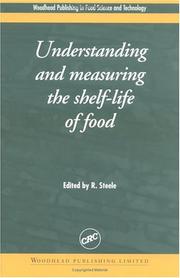| Listing 1 - 3 of 3 |
Sort by
|

ISBN: 1855737329 9786610373062 1280373067 185573902X 9781855739024 9781855737327 9780849325564 0849325560 9781280373060 Year: 2004 Publisher: Burlington : Elsevier Science,
Abstract | Keywords | Export | Availability | Bookmark
 Loading...
Loading...Choose an application
- Reference Manager
- EndNote
- RefWorks (Direct export to RefWorks)
The shelf-life of a product is critical in determining both its quality and profitability. This important collection reviews the key factors in determining shelf-life and how it can be measured.Part one examines the factors affecting shelf-life and spoilage, including individual chapters on the major types of food spoilage, the role of moisture and temperature, spoilage yeasts, the Maillard reaction and the factors underlying lipid oxidation. Part two addresses the best ways of measuring the shelf-life of foods, with chapters on modelling food spoilage, measuring and modelling glass tr
Voedselveiligheid --- Voedingsmiddelen : houdbaarheid --- 664.75 --- Food spoilage --- Food --- Date marking of food --- Food dating --- Freshness dating of food --- Open code dating of food --- Open dating of food --- Open shelf-life dating of food --- Pull dates of food --- Shelf-life dating of food --- Spoilage of food --- Food adulteration and inspection --- Shelf-life dating --- Labeling --- Microbiology --- Preservation --- Aliments -- Datage. --- Food -- Shelf-life dating. --- Food spoilage.
Book
ISBN: 0857092545 1613440294 1845697014 9781613440292 9780857092540 9781845697013 Year: 2011 Publisher: Oxford Philadelphia Woodhead Pub.
Abstract | Keywords | Export | Availability | Bookmark
 Loading...
Loading...Choose an application
- Reference Manager
- EndNote
- RefWorks (Direct export to RefWorks)
Ensuring that foods and beverages remain stable during the required shelf life is critical to their success in the market place, yet companies experience difficulties in this area. Food and beverage stability and shelf life provides a comprehensive guide to factors influencing stability, methods of stability and shelf life assessment and the stability and shelf life of major products.Part one describes important food and beverage quality deterioration processes, including microbiological spoilage and physical instability. Chapters in this section also investigate the effects of ingredients,
Food -- Preservation. --- Food -- Shelf-life dating. --- Food -- Storage. --- Food spoilage. --- Food --- Chemical & Materials Engineering --- Engineering & Applied Sciences --- Chemical Engineering --- Storage --- Shelf-life dating --- Beverages --- Deterioration. --- Preservation. --- Shelf-life dating. --- Engineering --- Food Science and Technology --- Date marking of food --- Food dating --- Freshness dating of food --- Open code dating of food --- Open dating of food --- Open shelf-life dating of food --- Pull dates of food --- Shelf-life dating of food --- Drinks --- Potable liquids --- Potables --- Food preservation --- Spoilage of food --- Liquids --- Food preservatives --- Food adulteration and inspection --- Labeling --- Microbiology --- Preservation
Book
ISBN: 1461438128 9786613702692 1461438136 1280792302 Year: 2012 Publisher: New York, NY : Springer US : Imprint: Springer,
Abstract | Keywords | Export | Availability | Bookmark
 Loading...
Loading...Choose an application
- Reference Manager
- EndNote
- RefWorks (Direct export to RefWorks)
Vibrational spectroscopy techniques, which have traditionally been used to provide non-destructive, rapid, and relevant information on microbial systematics, are useful for classification and identification. In conjunction with advanced chemometrics, infrared spectroscopy enables the biochemical signatures from microbiological structures to be extracted and analysed. In addition, a number of recent studies have shown that Fourier Transform Infrared (FT-IR) spectroscopy can help to understand the molecular basis of events, such as the adaptive tolerance responses expressed by bacteria when exposed to stress conditions in the environment, i.e. environments that cells confront in food and during food processing. The proposed Brief will discuss the published experimental techniques, data-processing algorithms, and approaches used in FT-IR spectroscopy to assist in the characterization and identification of microorganisms, to assess the mechanisms of bacterial inactivation by food processing technologies and antimicrobial compounds, to monitor the spore and membrane properties of foodborne pathogens in changing environments, to detect stress-injured microorganisms in food-related environments, to assess dynamic changes in bacterial populations, and to study bacterial tolerance responses.
Food -- Shelf-life dating. --- Food --- Fourier transform infrared spectroscopy --- Infrared spectroscopy --- Biology --- Health & Biological Sciences --- Biomedical Engineering --- Microbiology & Immunology --- Microbiology --- Fourier transform infrared spectroscopy. --- Infrared spectroscopy. --- Microbiology. --- Infra-red spectrometry --- Infrared spectrometry --- Spectrometry, Infrared --- Spectroscopy, Infrared --- FTIR spectroscopy --- Bacteriology --- Chemistry. --- Spectroscopy. --- Food Science. --- Spectroscopy/Spectrometry. --- Applied Microbiology. --- Biotechnology. --- Optical spectroscopy --- Fourier transform spectroscopy --- Sanitary microbiology --- Food science. --- Microbial biology --- Microorganisms --- Analysis, Spectrum --- Spectra --- Spectrochemical analysis --- Spectrochemistry --- Spectroscopy --- Chemistry, Analytic --- Interferometry --- Optics --- Radiation --- Wave-motion, Theory of --- Absorption spectra --- Light --- Spectroscope --- Science --- Qualitative --- Spectrometry --- Food—Biotechnology. --- Analytical chemistry
| Listing 1 - 3 of 3 |
Sort by
|

 Search
Search Feedback
Feedback About
About Help
Help News
News